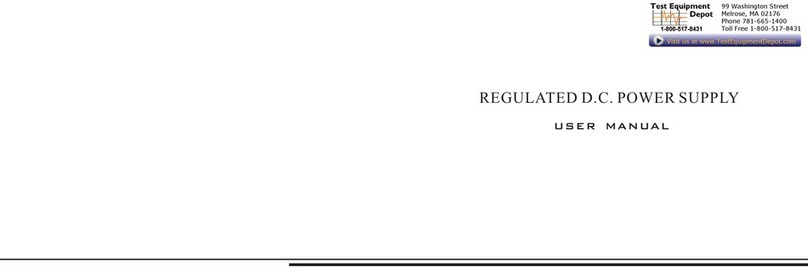
7
SERVICE AND WARRANTY INFORMATION
FACTORYSERVICE AND REPAIR :
Global Specialties will service and repair this instrument
free of charge for a period of one full year subject to the
warranty conditions stated below.
To obtain a return merchandise authorisation (RMA)
required for all returns, phone our customer service
department for a RMA and all shipping instructions :
ATTN : Customer Service Department
WARRANTY
Global Specialties warrants this device to be free from
defective material or workmanship for a period of 3 years
from the date of original purchase.
Global Specialties under this warranty is limited to repairing
the defective device when returned to the factory,shipping
charges prepaid, within three full years from the date of
original purchase.
Units returned to Global Specialties that have been
subject to abuse, misuse, damage or accident or have been
connected, installed or adjusted contrary to the instructions
furnished by Global Specialties, or that have been repaired
by unauthorised persons will not be covered by this
warranty.
Global Specialties reserves the right to discontinue models,
change specifications ,price or design of this device at any
time without incurring any obligation whatsoever.
The purchaser agrees to assume all liabilities for any
damages and/or bodily injury which may result from the use
or misuse of this device by the purchaser his employees or
agents. This warranty is in lieu of all other representations
or warranties expressed implied and no agent or
representitive of Global Specialties is authorised to assume
any other obligation in connection with the sale and purchase
of this device.
12
CONSTANT CURRENT MODE :
To select a constant current output, proceed as follows :
a. Short circuit the output terminals of the power supply.
b. Connect a DC Ammeter OR a shunt-digital voltmeter
(DVM) combination across the output terminals,
using appropriately-guaged wire and hardware. The
recommended current ratings for the ammeter or
he shunt and the wire must be at least 10% more
than the output current of the power supply model.
The ammeter or shunt-DVM combination must be
rated better than 0.5% accuracy.
c. Turn the VOLTAGE controls clockwise. And Turn the
CURRENT controls slowly clockwise. The CURRENT
control range will be from minimum to maximum
rated output current. Adjust CURRENT controls for
desired output current.
d. Compare the ammeter reading with the front panel
ammeter reading. Or, compare the DVM reading with
the front panel ammeter reading using I = V/R, where
V is the DVM reading and R is the DC shunt
resistance.
e. Open output terminals and adjust VOLTAGE
controls for maximum output as required by the load
conditions.
If a load change causes the voltage limit to be
exceeded, the power supply will automatically cross
over to constant voltage output at the preset voltage
limit and output current will drop proportionately. In
setting voltage limit, allowance must be made for
high peak voltages which can cause unwanted
crossover. Turn the VOLTAGE controls clockwise and
observe both the front panel voltmeter and the
DVM. Compare the DVM reading with the front
panel voltmeter reading to verify the accuracy of the
internal voltmeter
c.The VOLTAGE control range will be from minimum
to the maximum rated output voltage. Adjust desired
voltage by adjusting the voltage controls.
d. Short circuit output terminals and adjust CURRENT
controls for maximum output current as required by
the load conditions.
99 Washington Street
Melrose, MA 02176
Phone 781-665-1400
Toll Free 1-800-517-8431
Visit us at www.TestEquipmentDepot.com




























